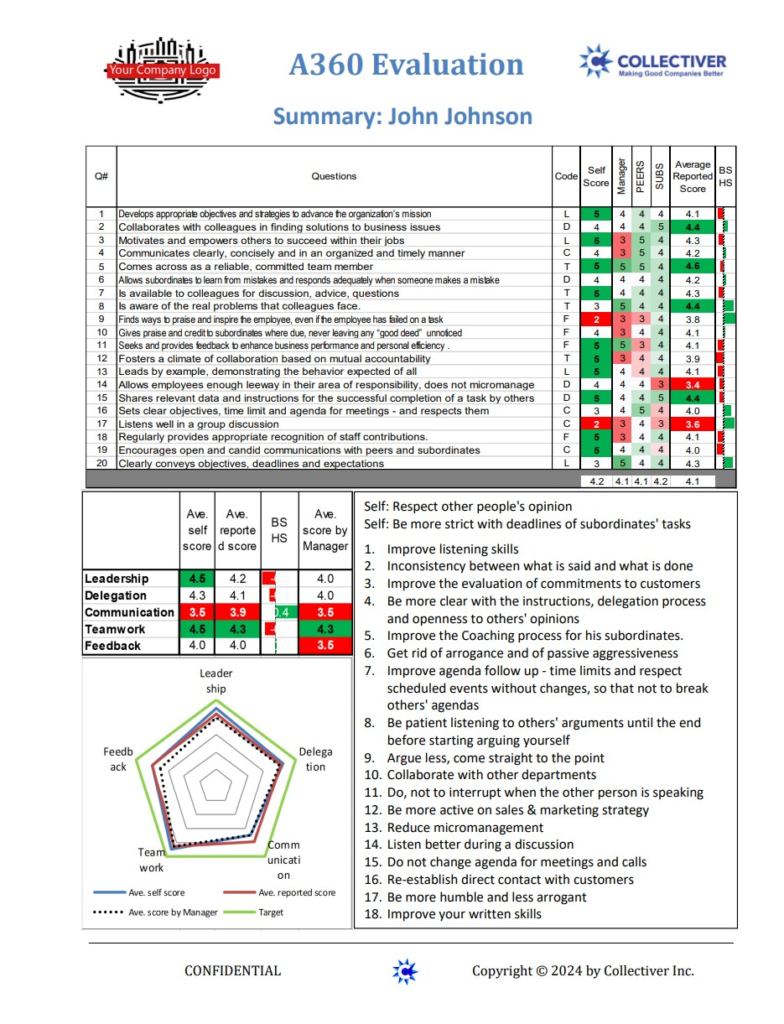360-degree Assessment: Best Practices

Every New Year celebration comes with the burden of annual performance reviews. More often than not, the review includes a dreaded 360-degree assessment. I am not going to spend your time on the well-documented downsides of this tool. On the contrary, the tool may be essential for people development – if you follow these Assessment-360 Best Practices.
(This is part 2. You may want to read Part 1 – Beyond Criticism: Redefining 360-Degree Feedback for Success)
If you are a people manager, here’s how the 360-degree review tool can bring a lot of value to your team.
Why I am positive about 360-degree reviews

In my consulting practice, I have administered 360-degree reviews dozens of times – consistently bringing positive results. However, we employ it as a targeted development tool rather than incorporating it into a company-wide performance review, which can sometimes support a forced ranking system at certain companies. When the Do’s and Don’ts discussed below are followed, the individuals under assessment receive constructive and actionable feedback, while assessors willingly provide their candid feedback assured in its confidentiality.
When properly applied, this review does not induce stress, escalate office politics, or erode trust within the company. Instead, it furnishes a structured assessment of the strengths and weaknesses of the selected individual(s).
Who Benefits from A360 Feedback
Assessment-360 (or A360 as we refer to it at Collectiver) is most effective as a performance improvement tool. While it could be utilized for annual performance reviews, I would not recommend doing so. Employing a 360-degree assessment for company-wide annual performance evaluations is ill-advised, regardless of the tool. Even with careful administration, the process of “everyone assessing everyone” inherently pits employees against each other, thus undermining the reliability of results.
However, as a leadership development tool, a properly orchestrated A360 provides an objective baseline for individual performance improvement. It also clearly outlines top-level performance improvement directions, offering the rated leader a valuable trajectory for development progress.
Running A360 in Your Organization: A Step-by-Step Guide
Preparation is key when implementing the A360 tool in your organization. While a manager can administer the tool for one or several targeted reports, outsourcing the process to a trusted consultant is recommended when the objective is to enhance the leadership skills of the entire management team, spanning from junior to C-level.
If you choose to conduct the 360 assessment using internal resources exclusively, avoid blindly adopting a questionnaire from another organization. Initiate the process by aligning your questions with your corporate values, ensuring a focused and tailored approach. Needless to say, it’s essential to have your values clearly defined beforehand.
Getting a third-party specialist involved may initially seem like an additional challenge and an unnecessary expense. However, it ensures that your assessment will yield the anticipated results, as specialists can adeptly customize and structure the questionnaire. With the right approach and communication skills, these specialists can gather and process genuinely objective and honest responses. Importantly, respondents are often more inclined to open up to an external specialist than to their supervisor or HR personnel. This external perspective fosters a more candid and unbiased assessment.
The consultant begins by obtaining the list of ‘ratees,’ or individuals to be assessed, from the manager responsible for overseeing their performance. Subsequently, the consultant approaches each selected individual to elucidate the assessment process. Each ‘ratee’ is then tasked with compiling a list of approximately 10 ‘raters’—employees with whom the ratee has engaged in active collaboration recently. The designated raters should encompass peers, reports (or subordinates), manager(s), and, optionally, clients or customers. It is this diverse array of perspectives that renders the assessment truly 360-degree in nature.
Engaging with an “outsider” proves to be more effective for the raters. Assured of confidentiality, they are inclined to candidly share their thoughts with the consultant, free from concerns about causing hurt feelings or getting entangled in office politics.
Simultaneously, ratees feel more at ease sharing their list with an “outsider” who won’t question their choices. This dynamic fosters a more open and honest exchange, enhancing the overall effectiveness of the assessment process.
I am frequently asked, “What if they provide a list of their friends with whom they are secretly colluding in mutual support?” That would be an improbable scenario. If the individual is a “positive” employee, the feedback content is likely to affirm that positivity. Conversely, if the person is perceived as “in need of improvement,” at least some of the suggested reviewers may indicate that with guaranteed anonymity. However, in the unlikely situation where an individual with subpar behavior manages to gather ten supporters from 360 degrees of the organization, it suggests a more significant organizational issue that extends beyond the scope of this assessment. In such cases, the company may need to address broader concerns about culture and collaboration.
Administering. I would recommend setting up the A360 questionnaire online, typically as a Google Form or an equivalent, depending on the company’s preferences. Numerous free options are available on the web. While the questions could be customized, my standard set of twenty core questions, utilizing a 1 to 5 scale, along with two or three open-ended questions, generally proves effective for most companies that prioritize leadership development. Paraphrasing Tolstoy, “All struggling companies are alike; each successful organization excels in its own way.”
Upon receiving the list(s) of raters, I personally approach each of them, preferably individually. My goal is to ensure they comprehend the assessment process, understand their role in it, and recognize its significance. I prioritize making them feel comfortable and safe in offering constructive feedback. Confidentiality is underscored, and I provide accessible communication channels, emphasizing their ability to reach out at any time if uncertainties arise.
Following our discussion, I will send an email to each rater (cc: the ratee) containing the link to the online form. In this communication, I will reiterate the key rules we’ve agreed upon and confirm the expected timeline for the assessment. To reinforce the sense of confidentiality and safety, individual emails will be sent, and to maintain privacy, I will refrain from including other raters’ names in the “To:” field. Similarly, a separate online form could be set up for each ratee, avoiding the use of a drop-down menu with all ratees’ names – for the same reasons.
Analysing the results. To analyze the feedback comprehensively, I use Excel or a similar tool, downloading all feedback into the same worksheet. This approach aids in identifying and visualizing trends and irregularities at both the individual and group levels (if the latter is expected by the client).
When studying the A360 data, there are three key areas to watch:
- Identifying the ratee’s strengths, reflected in the highest-rated behaviors.
- Identifying weaknesses or development needs – i.e. the lowest-rated behaviours.
- Scrutinizing for any inconsistencies in the feedback, such as strengths or development needs perceived differently by raters or categories of raters (e.g., peers vs. managers).
Special attention is given to gaps between the raters’ feedback and the ratee’s self-assessment, offering a unique indicator of leadership potential. Additionally, I watch out for outliers, pinpointing ratings that consistently deviate from those shared by others or from established averages.

It is a good practice to create a one-page summary with the individual graph and key findings, along with recommendations. You can access a sample A360 individual one-page report with sample questions and graphs, here. This profile is analyzed in the video mentioned earlier (jump directly to “How to Read 360 Data”).
Depending on the organization’s size, assessment scope, and client requirements (such as assessing the entire Executive Team), I may generate a separate report at the team level for the client, typically for the CEO who commissioned the A360. This team-level output can be highly customized based on the client’s specific needs. In essence, the focus remains on the same areas as with individual assessments, but now the “individual” is the executive team, referred to as the “Mr. Executive A360” summary.
Throughout the preparation and delivery of feedback reports, preserving the confidentiality of feedback is paramount. In certain instances, particularly with smaller teams, maintaining complete confidentiality can be challenging. My guiding principle – and another good practice – is to prioritize the confidentiality promised to all raters, even if it means presenting a less detailed report.
Debriefing involves delivering the final results to the team and the ordering manager. Ideally, this process unfolds in two steps. First, a concise session is conducted to explain the analysis process, as described earlier. Subsequently, individual meetings are arranged with each ratee to personally discuss their results using the provided one-page summaries.
Debriefing can, and often is, conducted remotely or through email. However, for all stages of this inherently “soft” and sensitive process, face-to-face in-person communication is highly recommended. Essentially, the coaching conversation during debriefing defines the value of the entire A360 exercise, assuming, of course, that the goal is genuine change rather than simply checking a box.
Additional debriefings with the client-orderer may be necessary, especially if there’s a need to separate discussions about their A360 feedback from the team-level assessment results. This approach is highly customer-specific, and relying on your knowledge of the client organization is key. In these instances, one-on-one coaching is essential, not just a standard recommendation.
Effectively executing a 360 Assessment, whether for an individual or team, significantly increases the likelihood of creating meaningful change.
DO’s:
- Use the tool for coaching and leadership development rather than annual appraisal.
- Whenever possible, hire an external professional to administer the assessment.
- Implement the tool in a focused manner, targeting specific individuals or teams for development.
- Clearly define the assessment’s purpose to yourself and participants, establishing expectations from the outset.
- Foster trust and ensure, communicate, and maintain confidentiality throughout the assessment process.
- Allow ratees to provide their lists of raters.
- Introduce yourself, ideally in person, to both the raters and the ratees.
- Customize the tool to meet your organization’s needs by adjusting questions and the survey’s length.
- Limit the number of questions to 20 or fewer, categorized clearly (max 5) in areas such as communication, leadership, delegation, decision-making, and teamwork, focusing on key areas for improvement.
- Provide raters with at least a week to complete the questionnaire to ensure more helpful information.
- Gather additional qualitative data by including open-ended questions to identify trends.
- Key Output: Develop an actionable plan. Collaborate with the rated individual to create a realistic plan based on feedback, outlining actionable steps for improvement. Identify relevant training or development opportunities that can support the leader in addressing specific areas for improvement.
- Limit the number of areas for improvement to one or two, as better focus makes behaviour change more likely to happen.
- Do not expect the ratee to do the logistics (send out info, the link, etc.); rather delegate these tasks to the consultant to ensure uniformity and create a sense of total confidentiality.
Bonus To-Do Point: The extent of the Preparation section in this article is not coincidental; detailed preparation requires the most effort. However, this dedicated investment of effort will undoubtedly prove well worth it.
DO-NOT’s
- Do not use the 360-degree assessment for performance reviews; there are better ways to gauge individual performance and maintain engagement.
- Refrain from applying the tool across the entire organization; instead, focus the A360 as a targeted effort.
- Do not send emails “to all”; prioritize confidentiality in every detail to safeguard trust.
- Avoid letting HR run it; they typically lack a vested interest in the result and are rarely trusted by the employees. However, HR-run reviews may still be preferable to manager-assessed reviews, which are often the most frustrating and disengaging.
- Do not consider using “specifically tailored software applications you can purchase online” (as advertised); Google Forms and Excel are sufficient for the job.
- Refrain from using questionnaires copied from the web; similar to copying Corporate Values from another website, “on-tap” questions may yield unhelpful “on-tap” answers.
Now that you know the ins and outs of the 360-degree assessment tool, it’s time to tap into its potential for coaching and leadership development. Remember, it’s not just about performance reviews – focus on growth! Explore the do’s and don’ts, prioritize detailed preparation, and embrace the coaching conversations during debriefing.
Whether you’re an individual looking to enhance your skills or a team ready for positive change, the A360 is your ally. Feel free to drop a comment, connect with Collectiver directly, send a request, or hit subscribe for more insights and clarifications (AND for a walk-through of the sample A360 report).
Let’s take your team to the next level together!
